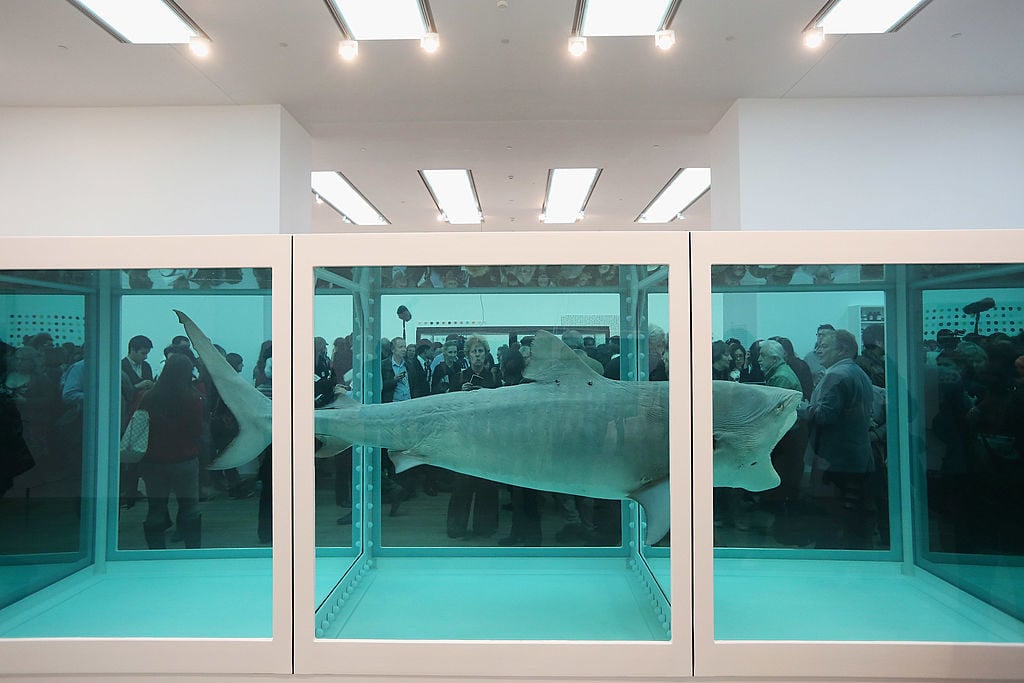Art World
Art Bites: How Damien Hirst Got His Shark(s)
The original tiger shark was replaced after it began to rot.

What’s the deal with Leonardo’s harpsichord-viola? Why were Impressionists obsessed with the color purple? Art Bites brings you a surprising fact, lesser-known anecdote, or curious event from art history. These delightful nuggets shed light on the lives of famed artists and decode their practices, while adding new layers of intrigue to celebrated masterpieces.
Spare a thought for the shark. It’s the year 2000, those heady days of novelty, of being gawked at and grumbled over are long past, and a Paris exhibition has just rejected it. The reasons: it stinks, it’s turning green, and its fin is falling off.
It’s well-known that Damien Hirst put a shark in a tank, gave it a long and vaguely philosophical title—The Physical Impossibility of Death in The Mind of Someone Living, in case you’ve forgotten—and duly launched a career as artist-provocateur. But what’s the shark’s story?
In 1991, Charles Saatchi, the advertising magnate and mega collector, offered to bankroll whatever project Hirst desired. What he wanted was a shark. More specifically, one “big enough to eat you.”
Vic Hislop, an Australian fisherman, did Hirst’s bidding, catching a 14-foot tiger shark in Queensland’s Hervey Bay, and shipping it (dead and on ice) to London for roughly $20,000.
Hirst lowered the shark into a minimalist vitrine and surrounded it in a five percent formaldehyde solution. It provoked the public, first at Saatchi Gallery and again at London’s Royal Academy. It came to be seen as an open-jawed encapsulation of the shock tactics of Hirst and his cohort of Young British Artists.

Damien Hirst poses in front of his artwork entitled The Physical Impossibility of Death in the Mind of Someone Living (1991) in the Tate Modern, 2012. Photo: Oli Scarff/Getty Images.
The good times didn’t last. The shark’s skin grew wrinkly, the tank solution turned gloomy. The addition of bleach didn’t help. Saatchi’s curators decided to stretch the skin over a fiberglass mold. The rotting stopped, but the fear factor was diminished.
This didn’t dissuade hedge fund billionaire Steven Cohen. In 2004, he bought it for $8 million. First, though, Hirst replaced the shark. He bought a middle-aged female shark (Queensland again) and had it shipped in a 20-foot freezer with a backup generator. He then made the work anew in his Gloucestershire studio.
Working alongside a fish scientist at the Natural History Museum, Hirst’s team soaked the shark for two weeks in a seven percent formaldehyde solution. To aid absorption, they drilled tiny holes in the skin and injected the shark further. The tank was also refurbished.
Detractors argued it wasn’t the same work. Hirst said the work was conceptual and its intention—to terrify a viewer into confronting their mortality—was the same. One group not assuaged? Animal rights activists. The sharks are but two of an estimated 900,000 animals to have died for the sake of Hirst’s art.





